Odyssey Group Highlights
Check out the latest news from around the company—exciting team and individual work and accomplishments that have contributed to the success of our customers’ missions over the last six months.
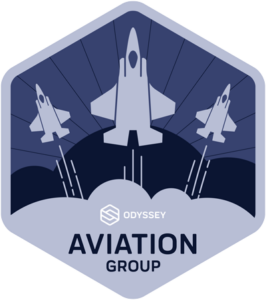
Aviation Group
In Oct 2024, Odyssey was awarded a five-year $531M contract to provide cross-cutting Advisory and Assistance Services (A&AS) to the USAF PEO for Intelligence, Surveillance, Reconnaissance (ISR) and Special Operations Forces (SOF) and Air Force Tactical Exploitation of National Capabilities (TENCAP) organization. Odyssey will contribute to the $22B ISR and SOF portfolio, enabling faster delivery of innovative warfighting capability as well as emerging technologies through partnership with AF TENCAP. Among the systems we will be supporting are helicopters, sensors, the CV-22 and OA-1 aircraft, as well as systems unique to Special Operations Forces.
Leading up to contract execution, which began 29 Dec 24, the Aviation Group successfully completed six major transition milestones ahead of schedule. This included transitioning 90 incumbents plus one additional employee (91 total)—a 98% retention rate—and culminated with all employees ready for contract execution on 19 Dec 2024. A major feat during the holiday season!
Due to the impeccable planning, placement events, employee engagement, and a solid WI transition Team, we’ve achieved early success strengthening our reputation as a trusted partner and positioning us for continued growth and excellence.
Odyssey has had remarkable success in executing the first 60 days of this new partnership—a direct reflection of the hard work, collaboration, and dedication of our entire team. In a very short period, Odyssey showcased its commitment to the Helicopter Program Office (HPO) and TENCAP leadership with zero turnover, Odyssey’s first-ever Flight and Ground Operation Procedures approved—a contractual requirement for HPO Flight Test, as well as exceptional contract performance highlighted in Contract Feedback Reports (CFRs)—and we’re just getting started! Transitions continue with additional AF TENCAP positions 28 Mar 2025, Sensors Directorate 22 May 2025, and the Personnel Recovery Division (WIS/SOF) 1 Jun 2025.
On the legacy Intelligence, Surveillance, Reconnaissance and Special Operations Forces (ISR-SOF) Directorate Task Order, the Directorate celebrated its final delivery of the HC-130J Combat King II and MC-130J Commando II series of planes in November 2024. The last MC-130J arrived at Wright-Patterson Air Force Base in Dayton Ohio, where it is receiving upgrades at the Rapid Development Integration Facility (RDIF), a specialty manufacturing office within ISR-SOF.
The HC/MC-130J programs were both stood up in early 2008. The Odyssey Team has been instrumental in the programs’ success since September 2016 starting with our initial contract supporting the ISR-SOF Directorate.
Today, the HC-130J serves as USAF’s only dedicated fixed-wing Personnel Recovery platform and the MC-130J supports special operations forces through infiltration, exfiltration and resupply missions, as well as with aerial refueling capabilities.
Attendees at the final delivery ceremony (left to right): Ron Smith, Systems Engineer, Lt Col Sarah Storm, HC/MC-130J Materiel Leader & Chief, Elan Smith, Avionics Engineer, Alan Beltz, Program Manager, Brenda Weatherspoon, Director ISR & SOF Division, Dan Clinger, Program Manager, Cathy Born, Administrative Support, Lisa Lanter, Configuration Manager, Lisa Colombe, Configuration Manager, Sylvia Logan, Configuration Manager, Julie Kassner, Acquisition Analyst, and Sydney Huck, Acquisition Analyst.

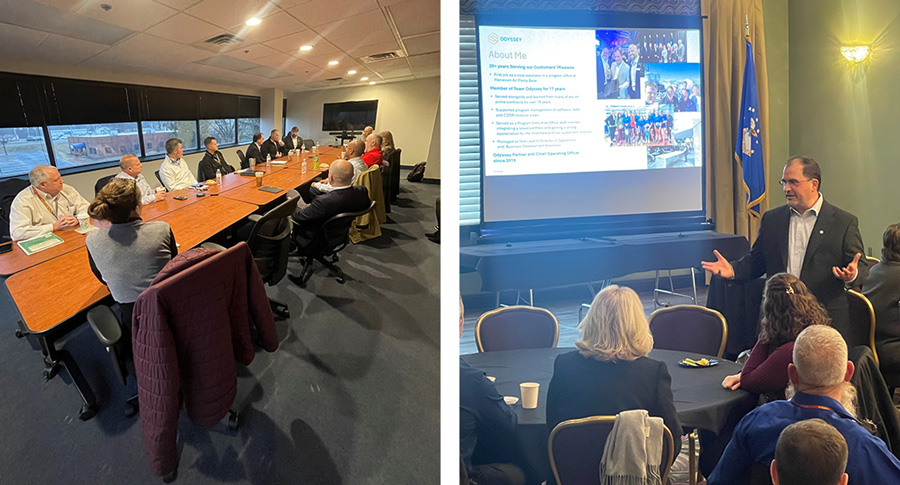
On February 12, 2025, Odyssey Dayton / WPAFB Personnel joined new CEO Matt Kasberg and other Odyssey leaders at the Wright-Patterson Club for a CEO Town Hall meeting that featured updates on Odyssey’s leadership transition, our 2024 performance, and our strategy / objectives for 2025-2027.
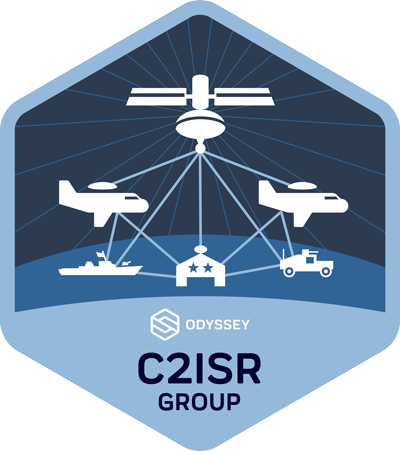
C2ISR Group
Since the C5ISR Group has been officially split into Command & Control Intelligence Surveillance and Reconnaissance (C2ISR) and Communications Cyber Networks & Nuclear (CCN2), this is our last combined group news article. And it’s been an exciting last few months with new contract wins, individual accomplishments, team awards, and company social events.
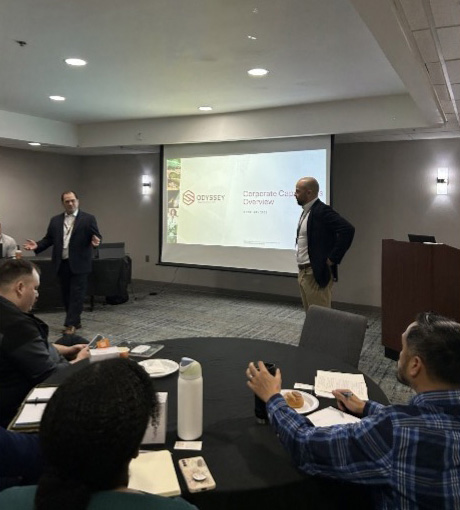 To begin, C5ISR had two big wins. First, at long last after months of enduring two protests, our new Communications & Networks PEO (HN) contract as a subcontractor is now up and running. Our incumbent team from HNJ along with about 60 new employees completed onboarding and started work on 3 February and we welcomed the last group in San Antonio, Texas. Led by Mike Petroskey and accompanied by Matt Kasberg, Kevin Connolly, Bill Decker, Leah Pfeifle, Suraiea Hussain, Max Kachur, Kelli McBride, Jamie Lufkin, and Tim Letourneau, the team traveled to our newest company work location and personally minted them Odyssey employees. Bringing a variety of crypto related specialties, they add a new dimension to our capabilities.
To begin, C5ISR had two big wins. First, at long last after months of enduring two protests, our new Communications & Networks PEO (HN) contract as a subcontractor is now up and running. Our incumbent team from HNJ along with about 60 new employees completed onboarding and started work on 3 February and we welcomed the last group in San Antonio, Texas. Led by Mike Petroskey and accompanied by Matt Kasberg, Kevin Connolly, Bill Decker, Leah Pfeifle, Suraiea Hussain, Max Kachur, Kelli McBride, Jamie Lufkin, and Tim Letourneau, the team traveled to our newest company work location and personally minted them Odyssey employees. Bringing a variety of crypto related specialties, they add a new dimension to our capabilities.
Only a few weeks prior, we stood-up another new contract at Warner Robins, Georgia. Under this subcontract, Odyssey is supporting Air Force Distributed Common Ground System (DCGS) and Infrastructure within the C3BM portfolio. Our 20 new employees 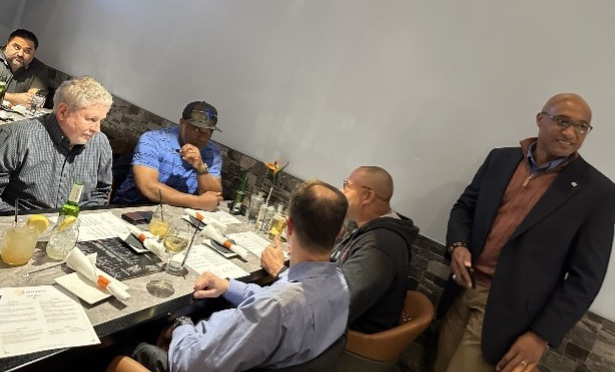 provide critical intelligence, technical, logistical, and other specialty skills. This group of employees were welcomed to the company by Aaron Hairston, Scott Bingham, Suraiea Hussain, and Michael Laurie. The new group was further integrated into the company with an invitation to attend a combined Aviation and C5ISR Winter Social in January. Despite the threat of snow in southern Georgia that evening, an Odyssey team that just doubled in size enjoyed a nice night at a local restaurant.
provide critical intelligence, technical, logistical, and other specialty skills. This group of employees were welcomed to the company by Aaron Hairston, Scott Bingham, Suraiea Hussain, and Michael Laurie. The new group was further integrated into the company with an invitation to attend a combined Aviation and C5ISR Winter Social in January. Despite the threat of snow in southern Georgia that evening, an Odyssey team that just doubled in size enjoyed a nice night at a local restaurant.
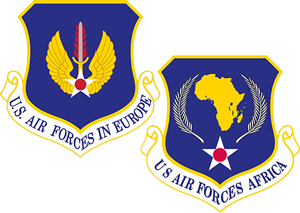 The Odyssey Team in Germany plays a pivotal role in supporting the United States Air Forces in Europe (USAFE), delivering exceptional programmatic, acquisitions, and systems engineering expertise for critical Combatant Command (COCOM) and Major Command (MAJCOM) initiatives. Their contributions span numerous high-profile programs, including Air Base Air Defense (ABAD), which protects key installations, and Consolidated Mission Solutions (CMS), aimed at enhancing mission readiness through streamlined processes. Additionally, the team ensures smooth base operations through USAFE Base Operations Services (UABOS) and drives greater operational efficiency via Continuous Process Improvement (CPI). Together, these efforts help sustain USAFE’s operational effectiveness and adaptability to dynamic mission requirements. A key element of this support comes through close collaboration with the USAFE-AFAFRICA Warfare Center (UAWC), which has reshaped acquisition and programmatic processes to enable the rapid development of critical capabilities. The UAWC is instrumental in providing program management, cross-domain security (CDS), and multi-level security (MLS) solutions, facilitating advanced training for both U.S. and NATO forces. Some key initiatives over the past few months have been providing systems engineering support for the EUCOM Joint Integrated Test and Training Center (JITTC), program management of the F-35 FENIX program, and the design of next-generation architecture for combined arms simulations. By delivering comprehensive support and innovation-driven solutions, the Odyssey team (A8I/B and A3 UAWC personnel) is ensuring that the U.S. and our allies maintain a strategic advantage in an increasingly complex defense environment.
The Odyssey Team in Germany plays a pivotal role in supporting the United States Air Forces in Europe (USAFE), delivering exceptional programmatic, acquisitions, and systems engineering expertise for critical Combatant Command (COCOM) and Major Command (MAJCOM) initiatives. Their contributions span numerous high-profile programs, including Air Base Air Defense (ABAD), which protects key installations, and Consolidated Mission Solutions (CMS), aimed at enhancing mission readiness through streamlined processes. Additionally, the team ensures smooth base operations through USAFE Base Operations Services (UABOS) and drives greater operational efficiency via Continuous Process Improvement (CPI). Together, these efforts help sustain USAFE’s operational effectiveness and adaptability to dynamic mission requirements. A key element of this support comes through close collaboration with the USAFE-AFAFRICA Warfare Center (UAWC), which has reshaped acquisition and programmatic processes to enable the rapid development of critical capabilities. The UAWC is instrumental in providing program management, cross-domain security (CDS), and multi-level security (MLS) solutions, facilitating advanced training for both U.S. and NATO forces. Some key initiatives over the past few months have been providing systems engineering support for the EUCOM Joint Integrated Test and Training Center (JITTC), program management of the F-35 FENIX program, and the design of next-generation architecture for combined arms simulations. By delivering comprehensive support and innovation-driven solutions, the Odyssey team (A8I/B and A3 UAWC personnel) is ensuring that the U.S. and our allies maintain a strategic advantage in an increasingly complex defense environment.
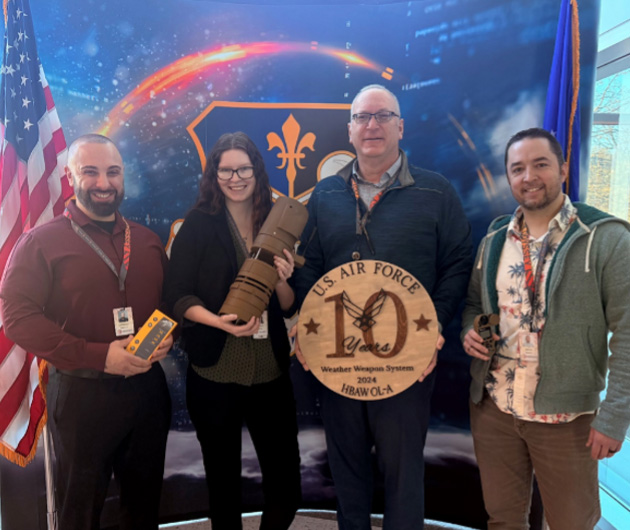 The Odyssey Team supporting Air Force Electronic Systems Weather Operations (HBA) at Offutt AFB, Nebraska, recently launched a quarterly “working lunch” program, where both predetermined and ad hoc topics are discussed over a complimentary meal. These morale-boosting events additionally serve to check the overall wellness of the distributed team members, along with fostering a foundation of trust for interpersonal relationships. The working lunches have proven to be an effective opportunity to collaborate on problem-solving, ensuring key information awareness and clarity, and identifying synergistic opportunities to deliver increased mission value to our DoD customers. To date, during these events, the team triumphantly tackled monthly status report improvement, conflict resolution with partner organizations and integrated product teams, work/life balance tips, personal/professional goal alignment, and advancements towards specific work center objectives. Maybe just as
The Odyssey Team supporting Air Force Electronic Systems Weather Operations (HBA) at Offutt AFB, Nebraska, recently launched a quarterly “working lunch” program, where both predetermined and ad hoc topics are discussed over a complimentary meal. These morale-boosting events additionally serve to check the overall wellness of the distributed team members, along with fostering a foundation of trust for interpersonal relationships. The working lunches have proven to be an effective opportunity to collaborate on problem-solving, ensuring key information awareness and clarity, and identifying synergistic opportunities to deliver increased mission value to our DoD customers. To date, during these events, the team triumphantly tackled monthly status report improvement, conflict resolution with partner organizations and integrated product teams, work/life balance tips, personal/professional goal alignment, and advancements towards specific work center objectives. Maybe just as  important, the lunches are a great opportunity for comradery and some work place fun. Pictured are: Chris Dawiczyk, Kandyce Hunter, Dave DuBois, and Mike Biastock.
important, the lunches are a great opportunity for comradery and some work place fun. Pictured are: Chris Dawiczyk, Kandyce Hunter, Dave DuBois, and Mike Biastock.
Not only is HBD “The Place to Be”, they are award winners! Theater Battle Control, with the support of a powerhouse Odyssey team won the 2024 David Packard Award at Secretary of the Air Force Level. We’ve come to expect great things from this team, but this takes it to a new level.
Finally, all of C5ISR is super proud of Kristine Grimsom for being selected as the Odyssey Core Values Winner this year. She’s the epitome of what each of us in C5ISR hope to emulate.
The NC3 Perspective
On 17 October, Odyssey started day one of contract execution to support the Nuclear Command, Control, and Communications (NC3) Integration Directorate at Hanscom AFB, MA. The NC3 Professional Advisory and Assistance Services (PAAS) contract provides Acquisition Program Management, Configuration Management, Security, Cost, Contracting, and Administrative support for the Nuclear, Command, Control and Communication (NC3) Directorate, Air Force Nuclear Weapons Center (AFNWC), Hanscom Air Force Base (HAFB), MA, Kirtland Air Force Base (KAFB), NM, and Eglin AFB, FL, Peterson SFB, CO, Pentagon, and Offutt AFB, NE.
In total, 109 personnel provide support to 23 different programs across the NC3 Integration Directorate and have done so in seamless fashion. The first weeks of the contract saw preparation and briefing of Fiscal Year 25 (FY25) Baseline Execution Reviews to support the program, which was spearheaded by our own Michael Lademan. Lademan’s efforts over the last year led to his being recognized by the NC3 Directorate at the AFCEA Unsung Heroes event in December.
During the transition period and initial contract execution, the team has stood up to support excellent contract execution for our NC3 Integration Directorate government partners. Our team is comprised of our Senior PM, Zach Cerovac, who also supports the Senior Leader Network program, and our Division Team Leads and Site Leads: Dan Hall, Futures Division and Operations Division Team Lead; Michael Lademan, Directorate Front Office and Program Execution Group Team Lead; Jon Sicard, Strategic Communications Division Team Lead; Mr. Andrew Manvell, NC Networks Division Team Lead; Hannah Herman, Sustainment Division & Peterson Site Lead; and Jay Williams, Kirtland Site Lead. Their leadership and guidance has brought about collaboration with our 3 subcontractor business partners via weekly team meetings that have helped ensure the government receives excellent support. These individuals bring decades of experience from various previous projects and contracts to help make the NC3 Odyssey Team strong and provide dedicated A&AS support that the government needs to support its 23 programs across the portfolio.
Finally, a huge thanks goes out to the NC3 Integration Contract Transition Team that helped bring onboard all the great talent. In the less than 60 days to kick off the contract, the team exceeded all 6 major milestones, with retaining over 90% of the talent from the last contract and getting everyone CAC access and proper security clearances on day one with zero issues. The contract currently has a 98% fill rate and would be full, save a position or two with some very unique skillsets, and is eagerly waiting for the status of the Fact of Life mod that will bring on more positions to support the Nuclear Enterprise. The team continues to deliver accurate cost reporting, personnel hiring updates, and status of actions to the government while receiving accolades from the government on speed of startup and amount of top-tier talent retained. As we go into the next quarter, there will be lots of great accomplishments to highlight as we support this critical Air Force acquisition portfolio.
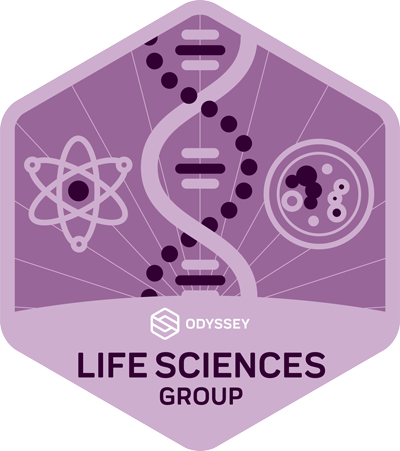
Life Sciences Group
Odyssey’s Life Sciences Group utilizes a broad network of health science professionals to provide subject matter expertise across a diverse range of therapeutic areas including infectious disease, polytrauma, and traumatic brain injury.
Our focus within the Life Sciences Group includes research support services and solutions that aim not only to improve warfighter health, performance, resilience and readiness, but also to develop healthcare solutions for medical treatment facilities in the Government sector. Here are some highlights of the great work our teams have been doing.
Odyssey WRAIR Blast Induced Neurotrauma group (BINT)
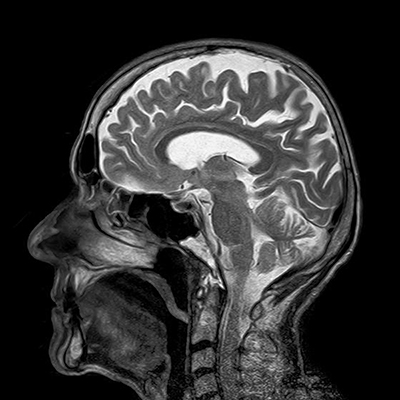 Under Odyssey’s newest contract, awarded in November 2024, our Preclinical Research Assistant in the Blast Induced Neurotrauma group (BINT) is providing critical experience and expertise to support the research. Our research assistant’s primary project involves the study of synaptopathy (damage to peripheral synapses, due to Blast exposure, that lead to perceptual hearing difficulties) and regeneration of those synapses through the use of FDA approved drugs in a pig model. Another project on the horizon will examine the efficacy of Fibroblast Growth Factors (FGF and bFGF) in the repair of the eardrum, post traumatic injury from blast waves, in a rat model.
Under Odyssey’s newest contract, awarded in November 2024, our Preclinical Research Assistant in the Blast Induced Neurotrauma group (BINT) is providing critical experience and expertise to support the research. Our research assistant’s primary project involves the study of synaptopathy (damage to peripheral synapses, due to Blast exposure, that lead to perceptual hearing difficulties) and regeneration of those synapses through the use of FDA approved drugs in a pig model. Another project on the horizon will examine the efficacy of Fibroblast Growth Factors (FGF and bFGF) in the repair of the eardrum, post traumatic injury from blast waves, in a rat model.
Odyssey WRAIR Biological Research and Development (BRD)
 Within the WRAIR Biological Research and Development (BRD) Section of the Center for Infectious Disease Research (CIDR), Odyssey’s Scientist guides the Structural Vaccinology group’s efforts to use a proprietary vaccine platform that is easily modified to work against most infectious agents. With much of the pre-clinical work completed, she is leading the collaboration with the WRAIR FDA approved cGMP Pilot Bioproduction Facility (PBF) to finalize the necessary Standard Operating Procedures (SOPs) and Batch Production Records (BPRs) for production of clinical trial material. Most recently, the collaboration performed a mock cGMP run and our scientist has been working with WRAIR’s Tech Transfer team on final preparations for the final product cGMP run, expected in February, 2025. As this projects reaches completion, our scientist is beginning preparations for the next product in the pipeline based on the DoD’s needs.
Within the WRAIR Biological Research and Development (BRD) Section of the Center for Infectious Disease Research (CIDR), Odyssey’s Scientist guides the Structural Vaccinology group’s efforts to use a proprietary vaccine platform that is easily modified to work against most infectious agents. With much of the pre-clinical work completed, she is leading the collaboration with the WRAIR FDA approved cGMP Pilot Bioproduction Facility (PBF) to finalize the necessary Standard Operating Procedures (SOPs) and Batch Production Records (BPRs) for production of clinical trial material. Most recently, the collaboration performed a mock cGMP run and our scientist has been working with WRAIR’s Tech Transfer team on final preparations for the final product cGMP run, expected in February, 2025. As this projects reaches completion, our scientist is beginning preparations for the next product in the pipeline based on the DoD’s needs.
Odyssey WRAIR Brain Trauma and Neuroprotection (BTN)
 The WRAIR Brain Trauma and Neuroprotection (BTN) branch within the Center for Military Psychiatry and Neuroscience (CMPN) performs research to establish solutions addressing capability gaps that exist at all levels of traumatic brain injury (TBI) care, with special emphasis on prolonged field care. The Odyssey Team recently won the recompete for this program and began serving as the prime contractor on November 20, 2024. This continues Odyssey’s scientific and research associate staffs’ commitment to WRAIR BTN, which began in 2016. Our staff focuses on various therapeutic approaches such as novel drugs, cellular therapies and manipulation of the brain’s physical condition by reducing temperature and intracranial pressure, all with the intent of preserving neurologic tissues and function.
The WRAIR Brain Trauma and Neuroprotection (BTN) branch within the Center for Military Psychiatry and Neuroscience (CMPN) performs research to establish solutions addressing capability gaps that exist at all levels of traumatic brain injury (TBI) care, with special emphasis on prolonged field care. The Odyssey Team recently won the recompete for this program and began serving as the prime contractor on November 20, 2024. This continues Odyssey’s scientific and research associate staffs’ commitment to WRAIR BTN, which began in 2016. Our staff focuses on various therapeutic approaches such as novel drugs, cellular therapies and manipulation of the brain’s physical condition by reducing temperature and intracranial pressure, all with the intent of preserving neurologic tissues and function.
Odyssey’s Team is continuing its Combat Casualty Care Research Program (CCCRP) funded research to evaluate the FDA-approved blood pressure drug, Bumetanide, for its ability to reduce cerebral edema immediately following a penetrating brain injury. Small animal studies are currently comparing different administration approaches, specifically Intramuscular (IM) and continuous Intravenous (IV). Another project in this group is evaluating a new medical Osmotherapy device for its ability to reduce intracranial pressure post-TBI. Odyssey’s Mitochondrial Research Team is currently studying Acetate-based energy supplements that may preserve mitochondria function after TBI and a new drug that supports neuroplasticity and repair. In addition, this group continues to identify and test TBI prognostic biomarkers found in the blood, micro-RNAs (miRNAs). An exciting new project centers around the transplantation of mitochondria. More to this story in the next newsletter.
WRAIR Department of Diarrheal Disease Research (DDR)
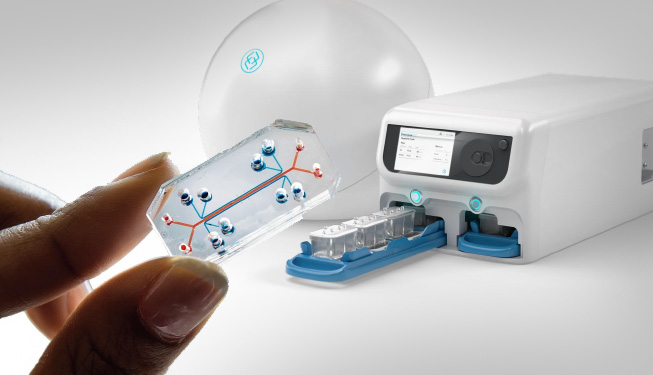 Odyssey’s senior scientist and research associates continue to develop and test novel vaccines and therapeutics against enteric bacterial diseases, including Shigellosis and travelers’ diarrhea. These diseases and the disease caused by Campylobacter jejuni collectively account for the highest morbidity rate of any infectious disease among deployed U.S. service members. Ongoing projects include the testing of high-titer anti-Shigella antibodies in cows, development of a commercial ex vivo “Intestine on a Chip” technology used to test the effectiveness of therapeutics against these diseases in a real-time living system, and a collaboration with the Naval Medical Research Center (NMRC) to develop a novel vaccine against Campylobacter jejuni, and investigation of Antimicrobial Peptides (AMPs) as a potential therapeutic against Shigella infection. Each peptide can have a different mechanism of action, allowing them to be combined into a cocktail with broad spectrum activity. Another critically important collaborative project with the University of Maryland (UMD) involves the utilization of Bacterial Enzymatic Combinatorial Chemistry (BECC) to modify the live-attenuated Shigella vaccine strains currently being tested in clinical trials. These modifications, directed against the bacteria’s lipid A molecule, are intended to reduce the endotoxicity and reactogenicity of the vaccines, thus making them safer and more tolerable in target populations such as children and the immune-compromised.
Odyssey’s senior scientist and research associates continue to develop and test novel vaccines and therapeutics against enteric bacterial diseases, including Shigellosis and travelers’ diarrhea. These diseases and the disease caused by Campylobacter jejuni collectively account for the highest morbidity rate of any infectious disease among deployed U.S. service members. Ongoing projects include the testing of high-titer anti-Shigella antibodies in cows, development of a commercial ex vivo “Intestine on a Chip” technology used to test the effectiveness of therapeutics against these diseases in a real-time living system, and a collaboration with the Naval Medical Research Center (NMRC) to develop a novel vaccine against Campylobacter jejuni, and investigation of Antimicrobial Peptides (AMPs) as a potential therapeutic against Shigella infection. Each peptide can have a different mechanism of action, allowing them to be combined into a cocktail with broad spectrum activity. Another critically important collaborative project with the University of Maryland (UMD) involves the utilization of Bacterial Enzymatic Combinatorial Chemistry (BECC) to modify the live-attenuated Shigella vaccine strains currently being tested in clinical trials. These modifications, directed against the bacteria’s lipid A molecule, are intended to reduce the endotoxicity and reactogenicity of the vaccines, thus making them safer and more tolerable in target populations such as children and the immune-compromised.
Odyssey WRAIR WID
 Odyssey research scientists and technicians in the WRAIR Wound Infection Department (WID) are actively identifying, developing and optimizing small molecule, bacteriophage and monoclonal antibody therapeutics against several families of multi-drug resistant (MDR) bacterial and fungal pathogens that threaten the warfighter. Currently, the Structural Biology group is focused on the MDR pathogen Acinetobacter baumannii. Five different compounds have been identified and show promise against the bacteria. Optimization studies are being conducted in vitro to prepare for small animal experiments. The Human Monoclonal Antibody Platform (HMAP) group led by one of Odyssey’s most senior scientist is very busy performing research studies under six different funded grants. Work includes developing and characterizing monoclonal antibodies against Staphylococcus aureus, Acinetobacter baumannii and Klebsiella pneumoniae. A new project is a collaboration with an international company to test Reactive Oxygen Species (Rox) as antimicrobial treatment for wound infections. Our Bacteriophage group (BT) is building on past successes to optimize novel bacteriophage cocktails specific to MDR pathogens. One of the most recent cocktails developed is currently undergoing a Phase 2b clinical trial to study its efficacy against Pseudomonas aeruginosa infections in patients with Cystic Fibrosis. Ongoing projects include the use of specialized cocktails that inhibit biofilm formation in bacterial lung infections. Our scientists in the Trauma Infection Group (TIR) work on strategies and products that have immediate real world applications in the treatment of wound infections on the battlefield. One of the newer funded project’s is the study of enzymatic debridement strategies to manage biofilm formation caused by Pseudomonas aeruginosa in the context of prolonged field care.
Odyssey research scientists and technicians in the WRAIR Wound Infection Department (WID) are actively identifying, developing and optimizing small molecule, bacteriophage and monoclonal antibody therapeutics against several families of multi-drug resistant (MDR) bacterial and fungal pathogens that threaten the warfighter. Currently, the Structural Biology group is focused on the MDR pathogen Acinetobacter baumannii. Five different compounds have been identified and show promise against the bacteria. Optimization studies are being conducted in vitro to prepare for small animal experiments. The Human Monoclonal Antibody Platform (HMAP) group led by one of Odyssey’s most senior scientist is very busy performing research studies under six different funded grants. Work includes developing and characterizing monoclonal antibodies against Staphylococcus aureus, Acinetobacter baumannii and Klebsiella pneumoniae. A new project is a collaboration with an international company to test Reactive Oxygen Species (Rox) as antimicrobial treatment for wound infections. Our Bacteriophage group (BT) is building on past successes to optimize novel bacteriophage cocktails specific to MDR pathogens. One of the most recent cocktails developed is currently undergoing a Phase 2b clinical trial to study its efficacy against Pseudomonas aeruginosa infections in patients with Cystic Fibrosis. Ongoing projects include the use of specialized cocktails that inhibit biofilm formation in bacterial lung infections. Our scientists in the Trauma Infection Group (TIR) work on strategies and products that have immediate real world applications in the treatment of wound infections on the battlefield. One of the newer funded project’s is the study of enzymatic debridement strategies to manage biofilm formation caused by Pseudomonas aeruginosa in the context of prolonged field care.
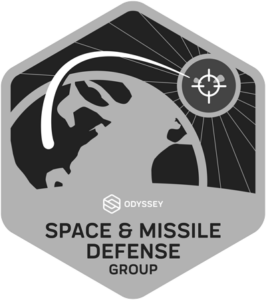
Space and Missile Defense Group
Customer Reorganization
The Space & Missile Defense customer for our two largest contracts went through a major reorganization, fundamentally changing the way in which they conduct business. This forced Odyssey’s contract leadership to morph our two contracts to align within their new structure. Prior to the reorganization D0164’s primary customer was  SSC/SZG whose primary mission was Space Domain Awareness system acquisition and sustainment, and D0180’s primary customer was SSC/SZQ whose primary mission was Missile Warning and Missile Defense system acquisition and sustainment. The reorganization moved the space system acquisition to the new SSC/SZB and moved the sustainment pieces to the Space Operation Center (SpOC) Mission Delta 2 – Space Domain Awareness and Mission Delta 4 – Missile Warning respectively.
SSC/SZG whose primary mission was Space Domain Awareness system acquisition and sustainment, and D0180’s primary customer was SSC/SZQ whose primary mission was Missile Warning and Missile Defense system acquisition and sustainment. The reorganization moved the space system acquisition to the new SSC/SZB and moved the sustainment pieces to the Space Operation Center (SpOC) Mission Delta 2 – Space Domain Awareness and Mission Delta 4 – Missile Warning respectively.
This new structure means that each contract supports two separate commanders—one combined commander for acquisition, and separate commanders for sustainment. The paradigm shift has forced the contract leadership to work even closer as they examine the seams and overlaps of the contracts to ensure we provide the customers with the best support possible.
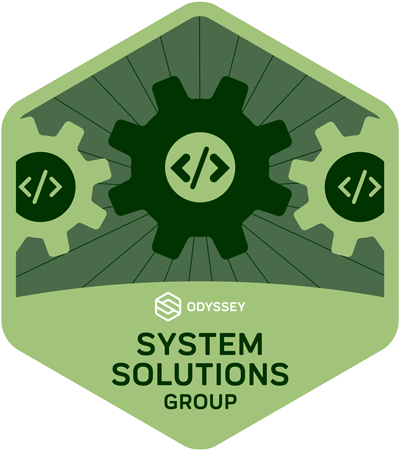
System Solutions Group
The Systems group has been very active supporting the Special Operations community since last update. Leveraging the strong relationships and operational expertise that Phil Freeman brings to the team, our Program and Engineering leads Tim Vockrodt and Andrew Kennedy respectively, have been working with the team to develop a next generation training / tracking application for the SOF community. Odyssey’s SOCOM and ACC customers continually praise this team for their commitment to the mission and quality work they produce.
Separately, Andrew Kennedy has been prototyping some impressive Artificial Intelligence capabilities that may have applicability for both internal and customer use—we will keep you updated!

Strategic Engagement
Odyssey stands up new Strategic Engagement Function!
In alignment with our corporate strategic objectives, Odyssey is proud to announce the stand up of a new Strategic Engagement (SE) function for the company! The SE mission is to “develop competitive advantage through strategic management of customer and partner relationships.” In practice, the SE function can be summarized in three words: “connecting the dots.”
From an external standpoint the SE Team is charged with forging connections to build Odyssey brand awareness in new markets while also strengthening our strong reputation and added value to current, foundational customers. Internal to Odyssey, the SE function will work to connect people, teams and build stronger alignment by sharing lessons learned, identifying opportunities for synergy across teams and functions, and ensuring consistency of Odyssey messaging. The SE team’s goal is to help make Odyssey stronger than ever while preparing the company for long-term resilience and growth.
Odyssey stalwart Erin Donlan (Schubmehl) serves as the SE Executive Director. Erin has built her career aligned to multiple Air Force mission areas over the course of 20+ years, and has excelled in a variety of direct, operational management and business development roles with Odyssey over the last 9 years. Erin has enlisted two very strong team members to help stand up the enduring SE function for Odyssey, Bob Johnson and Heather Lavigne.
Bob is an Air Force veteran who joined Odyssey in September, and in his short time with Odyssey he has already established himself as a go-to resource, successfully teaming with our Operational and Growth teams to add value to several efforts, most significantly establishing Odyssey’s C3BM presence in the National Capital Region! Bob spent most of his service as an Aircraft Maintenance officer, also serving as a Program Manager (PM) at Hanscom AFB, MA where he learned first-hand how valuable Odyssey employees are to ensuring the success of DoD Acquisitions programs.
Heather is the newest SE team member, joining the Odyssey team February following a career in Government service. Heather brings deep experience as a dedicated civil servant PM and leader, with experience in all phases of the systems acquisition lifecycle, from technology development and integration through modernization and sustainment. Heather has a very strong background in Enterprise Sourcing, Strategic Services, risk management and strategic messaging. She has watched Odyssey closely as we have proven ourselves as a small business industry leader, and she looks forward to being part of the Odyssey team serving from our field office in Beavercreek, Ohio.
In 2025 Erin, Bob and Heather together as a team will build the foundation of the SE function in direct alignment with our corporate priorities and strategic objectives. The team will be working in lockstep with Operational Leadership as well as the Growth Team and Technical Center to build customer mapping, evaluate strategic corporate partnerships and establish strategic messaging to emphasize our corporate offerings as an industry leader in information dominance, C5ISR, warfighter readiness and airborne strategic integration.
As the SE team establishes their footing, they will also look to bolster their strength by enlisting Odyssey members to support and serve as employee ‘Ambassadors.’ The SE team would love to hear from enthusiastic, action-oriented employees that are at the ready to represent the company by building upon their strong network connections, understand mission connections and see the strong value in relationship building and active engagement, internal and external to Odyssey in order to improve upon our strong Odyssey brand.
If you are interested in joining a small, agile team that is pumped to make Odyssey even better than we already are today, please reach out to Erin, Bob or Heather to express your interest get an idea about what a day in the life of Strategic Engagement is all about!

Growth Team
Over the past 6-12 months, Odyssey’s Business Development Group has gone through many changes to better serve the needs of today and perhaps more importantly, meet the challenges ahead. The mission of what is now the Growth Team is to drive new business growth by leveraging existing capabilities, identifying and capitalizing on strategic opportunities, fostering long-term partnerships, and delivering innovative solutions that meet the evolving needs of our customers and achieve our organizational goals. We do this with strategic purpose, intentional actions, and constant collaboration with our Executive Leadership Team, Group Executive Directors, the Executive Director of Strategic Engagement, and the Executive Director of our Technical Center. Over the last few months, the Growth team has restructured organizationally and is refocusing efforts to support Odyssey’s corporate objectives. Among those efforts include aligning our resources and processes to prioritize strategic growth initiatives, elevating our capture rigor and customer intimacy, planning effective and targeted marketing campaigns, and improving our proposal success rate. By focusing on a structure that promotes scalability, accountability, and a customer-centric approach, our Growth team can better seize emerging opportunities for market expansion and drive sustainable growth.
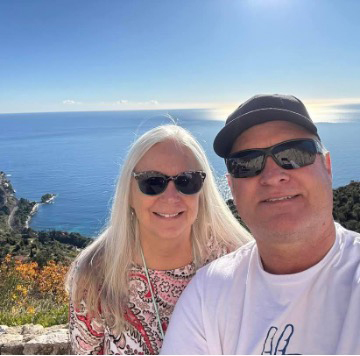 Tonya Torgeson, Executive Director, Growth leads the team—She is an experienced business development and growth professional with a proven track record for delivering tangible value and driving new business growth. With over 30 years of successful business development, operations execution, and program management expertise, she has built long-lasting customer relationships, developed capture strategies, established trusted partnerships, and shaped new business opportunities to meet and exceed growth targets. Tonya is applying her collaborative management and leadership approach with purposeful capture rigor to expand Odyssey’s growth pursuits in the full and open market. Outside of the office, Tonya and her husband Shawn enjoy spending time on the water as often as possible, hanging out with family and friends, and traveling to new places to explore and learn about the people, food, cultures, and traditions of other countries.
Tonya Torgeson, Executive Director, Growth leads the team—She is an experienced business development and growth professional with a proven track record for delivering tangible value and driving new business growth. With over 30 years of successful business development, operations execution, and program management expertise, she has built long-lasting customer relationships, developed capture strategies, established trusted partnerships, and shaped new business opportunities to meet and exceed growth targets. Tonya is applying her collaborative management and leadership approach with purposeful capture rigor to expand Odyssey’s growth pursuits in the full and open market. Outside of the office, Tonya and her husband Shawn enjoy spending time on the water as often as possible, hanging out with family and friends, and traveling to new places to explore and learn about the people, food, cultures, and traditions of other countries.
Other leadership functions within the team include the following:
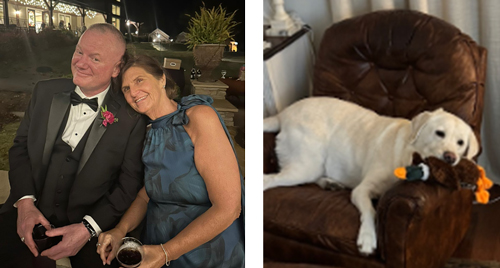 Rob Thomas, Director of Corporate Growth—Rob has been instrumental in driving key business initiatives and fostering valuable partnerships that have significantly benefited our organization. He will continue providing seamless oversight to Huntsville area programs, while expanding our team to include Business Development Managers for the Space, Army and Air Force portfolios to enhance our capabilities aligned to our strategic initiatives. These are new positions within the team intended to foster cross-functional collaboration between Growth, Operations, Enterprise Alignment, Strategic Engagement, and Technical Center functions, and to help accelerate the identification of new opportunities and improve our ability to respond to market demands. Rob’s leadership in this area is crucial as we continue to pursue new opportunities and drive our future growth. Rob and his wife Ann enjoy traveling, experiencing new wines, outdoor activities on the water, and spending time with family. They also love their retriever Cooper, who will never get closer to a duck than in the photo below.
Rob Thomas, Director of Corporate Growth—Rob has been instrumental in driving key business initiatives and fostering valuable partnerships that have significantly benefited our organization. He will continue providing seamless oversight to Huntsville area programs, while expanding our team to include Business Development Managers for the Space, Army and Air Force portfolios to enhance our capabilities aligned to our strategic initiatives. These are new positions within the team intended to foster cross-functional collaboration between Growth, Operations, Enterprise Alignment, Strategic Engagement, and Technical Center functions, and to help accelerate the identification of new opportunities and improve our ability to respond to market demands. Rob’s leadership in this area is crucial as we continue to pursue new opportunities and drive our future growth. Rob and his wife Ann enjoy traveling, experiencing new wines, outdoor activities on the water, and spending time with family. They also love their retriever Cooper, who will never get closer to a duck than in the photo below.
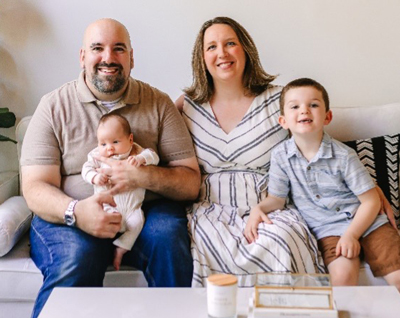 Sara Mullen, Associate Director, Proposals—Sara has managed several of our most critical proposal efforts while mentoring others on our proposal processes. She is our resident expert on HTRO proposals and has played an important role in securing our place on multiple GWAC vehicles. She will continue to build upon and improve the proposal process that has brought our organization so much success, ensuring compliance and responsiveness, and enhancing our ability to compete on increasingly complex and strategic opportunities. Sara leads our dedicated proposal team and is expanding the team to add a Proposal Writer (recruitment in process) and an additional Proposal Manager later in the year. Outside of work, Sara enjoys spending time with her husband, Mark, and their two young boys, Luke and Daniel.
Sara Mullen, Associate Director, Proposals—Sara has managed several of our most critical proposal efforts while mentoring others on our proposal processes. She is our resident expert on HTRO proposals and has played an important role in securing our place on multiple GWAC vehicles. She will continue to build upon and improve the proposal process that has brought our organization so much success, ensuring compliance and responsiveness, and enhancing our ability to compete on increasingly complex and strategic opportunities. Sara leads our dedicated proposal team and is expanding the team to add a Proposal Writer (recruitment in process) and an additional Proposal Manager later in the year. Outside of work, Sara enjoys spending time with her husband, Mark, and their two young boys, Luke and Daniel.
Hiring in process, Marketing Manager—we are recruiting for a Marketing Manager to join the team who will have responsibility for managing and executing all marketing activities, including internal/external communications, corporate memberships and sponsorships, tradeshows and event planning, and development of social media campaigns, marketing materials, brochures, presentations and website content. If you have a referral, apply here: Marketing Manager | Careers at Corporate Headquarters
 James Petroskey, GWAC Manager—James has supported the development of Odyssey’s capture processes and tools, optimized sales forecasts and revenue projections, provided capture support to Capture Managers and Executive Directors, and led several GWAC/IDIQ pursuits. His role includes providing oversight of all GWAC activities and assignments, collaborating with Capture Managers to support the capture management plan and associated strategies for each GWAC, identifying and qualifying new business opportunities to support pipeline development with Capture Managers, facilitating collaboration with the Technical Center, and participating in associated marketing initiatives. In his spare time, James enjoys watching the NBA Champion Boston Celtics, playing guitar, and spending time with his family: Wife Amy, son Jack and a daughter due this month.
James Petroskey, GWAC Manager—James has supported the development of Odyssey’s capture processes and tools, optimized sales forecasts and revenue projections, provided capture support to Capture Managers and Executive Directors, and led several GWAC/IDIQ pursuits. His role includes providing oversight of all GWAC activities and assignments, collaborating with Capture Managers to support the capture management plan and associated strategies for each GWAC, identifying and qualifying new business opportunities to support pipeline development with Capture Managers, facilitating collaboration with the Technical Center, and participating in associated marketing initiatives. In his spare time, James enjoys watching the NBA Champion Boston Celtics, playing guitar, and spending time with his family: Wife Amy, son Jack and a daughter due this month.
We also welcomed new members to our team last fall:
 Rick Shaffer was hired as a Capture Manager supporting Aviation growth. Rick brings a wealth of aviation experience to Odyssey, and a genuine enthusiasm for connecting with people and building strong, lasting relationships. He’s passionate about engaging stakeholders, networking, and collaborating to drive success in every project he takes on. Rick is originally from central Pennsylvania and, at 17, made the decision to join the U.S. Army. Serving as an Avionics, Electronics, and Armament Technician on OH-58D(R) Kiowa Warrior helicopters, he completed two combat deployments to Afghanistan, gaining invaluable experience in military aviation operations. After leaving the Army, Rick transitioned into the defense sector, initially working on helicopters before moving into training roles, where he instructed Army pilots and maintainers across the country. His ability to translate technical expertise into effective training led him to business development. In November of 2024, Rick joined Odyssey as the Aviation Capture Manger, bringing his understanding and expertise in Army Aviation acquisition. Outside of his career, Rick values time with his family. He married his wife in 2015, and they have three children. An avid outdoorsman, he enjoys playing golf and is passionate about waterfowl hunting.
Rick Shaffer was hired as a Capture Manager supporting Aviation growth. Rick brings a wealth of aviation experience to Odyssey, and a genuine enthusiasm for connecting with people and building strong, lasting relationships. He’s passionate about engaging stakeholders, networking, and collaborating to drive success in every project he takes on. Rick is originally from central Pennsylvania and, at 17, made the decision to join the U.S. Army. Serving as an Avionics, Electronics, and Armament Technician on OH-58D(R) Kiowa Warrior helicopters, he completed two combat deployments to Afghanistan, gaining invaluable experience in military aviation operations. After leaving the Army, Rick transitioned into the defense sector, initially working on helicopters before moving into training roles, where he instructed Army pilots and maintainers across the country. His ability to translate technical expertise into effective training led him to business development. In November of 2024, Rick joined Odyssey as the Aviation Capture Manger, bringing his understanding and expertise in Army Aviation acquisition. Outside of his career, Rick values time with his family. He married his wife in 2015, and they have three children. An avid outdoorsman, he enjoys playing golf and is passionate about waterfowl hunting.
 John Broughton was hired as a Sr. Capture Manager supporting Life Sciences growth. John is a distinguished leader in business development and capture management, encompassing over 20 years of experience with a specialized focus on the defense health and military medical markets. His track record includes securing multimillion-dollar contracts, GWACs, and IDIQ vehicles. With a deep understanding of the Federal GOVCON environment, he excels in strategic capture planning, proposal development, and partnership-building. He is known for establishing high-performing proposal teams that consistently secure contracts. His successful prepositioning efforts span a diverse range of areas, including R&D support, data analytics, information management, biomedical research, policy, program evaluation, performance and portfolio management, resilience programs, pre-clinical studies, logistics, and comprehensive program management. John joined Odyssey in September 2024, bringing his expertise in life sciences and adjacent markets. In his free time, he is an award-winning filmmaker and director with 20 years of experience. He segued that creative outlet into professional work with the Federal Government as a Project Manager on two video projects for Veteran Affairs: 1) three PSAs for the Veteran Affairs Volunteer Services (VAVS) and 2) a health wellness video for the Telephone Lifestyle Coach (TLC), which was created as a subcontractor to Optum and shown in the lobbies of all VA hospitals and clinics. Additionally, he managed two other video projects under different contracts, including 1) the DoD/VA Clinical Practice Guideline for the Management of Chronic Multisymptom Illness (CMI) and 2) a “Ted-Talk” style video for the Women’s Health Transition Training (WHTT) program, which offers training and support to women transitioning to civilian life.
John Broughton was hired as a Sr. Capture Manager supporting Life Sciences growth. John is a distinguished leader in business development and capture management, encompassing over 20 years of experience with a specialized focus on the defense health and military medical markets. His track record includes securing multimillion-dollar contracts, GWACs, and IDIQ vehicles. With a deep understanding of the Federal GOVCON environment, he excels in strategic capture planning, proposal development, and partnership-building. He is known for establishing high-performing proposal teams that consistently secure contracts. His successful prepositioning efforts span a diverse range of areas, including R&D support, data analytics, information management, biomedical research, policy, program evaluation, performance and portfolio management, resilience programs, pre-clinical studies, logistics, and comprehensive program management. John joined Odyssey in September 2024, bringing his expertise in life sciences and adjacent markets. In his free time, he is an award-winning filmmaker and director with 20 years of experience. He segued that creative outlet into professional work with the Federal Government as a Project Manager on two video projects for Veteran Affairs: 1) three PSAs for the Veteran Affairs Volunteer Services (VAVS) and 2) a health wellness video for the Telephone Lifestyle Coach (TLC), which was created as a subcontractor to Optum and shown in the lobbies of all VA hospitals and clinics. Additionally, he managed two other video projects under different contracts, including 1) the DoD/VA Clinical Practice Guideline for the Management of Chronic Multisymptom Illness (CMI) and 2) a “Ted-Talk” style video for the Women’s Health Transition Training (WHTT) program, which offers training and support to women transitioning to civilian life.
If you haven’t had a chance to meet with members of the team, reach out and let them know your strengths and capabilities for supporting new business opportunities, marketing initiatives, or proposal efforts. We also look forward to meeting you in person at upcoming Town Halls, conferences, and industry days or virtually through Teams meetings!

Talent Acquisition
Odyssey TA & HR Take Beverly: A Summit for the Ages
Last October, the Talent Acquisition and Human Resources teams did something epic—we gathered from all corners of the country (New York! Georgia! Colorado! Even Kansas!) for the first annual TA/HR Summit at the Wylie Inn and Conference Center in Beverly, Massachusetts. The mission? To connect, collaborate, and strengthen the partnership between TA and HR—because while we have distinct roles, we’re at our best when we work together. And wow, did we deliver.
 We dove deep into stimulating (yes, really!) discussions on employment law compliance, process improvements, and ways to join forces more often—because when TA and HR work together, magic happens. We also geeked out over DISC personality profiles, spending a half-day analyzing our own team dynamics and learning how to work together even more effectively. Turns out, some of us are natural-born leaders, others are analytical masterminds, and a few of us really love a good spreadsheet.
We dove deep into stimulating (yes, really!) discussions on employment law compliance, process improvements, and ways to join forces more often—because when TA and HR work together, magic happens. We also geeked out over DISC personality profiles, spending a half-day analyzing our own team dynamics and learning how to work together even more effectively. Turns out, some of us are natural-born leaders, others are analytical masterminds, and a few of us really love a good spreadsheet.
Of course, no summit would be complete without a little adventure, including an incredible dinner in Boston’s North End (because pasta makes everything better).
All-in-all the summit was a resounding success! We left with stronger connections, sharper collaboration skills, and maybe even a newfound appreciation for our own quirks. Can’t wait to see what next year’s summit has in store!
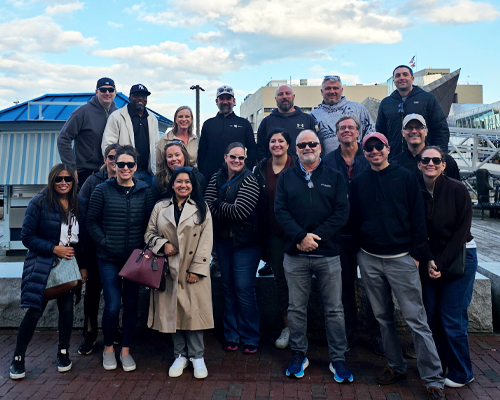
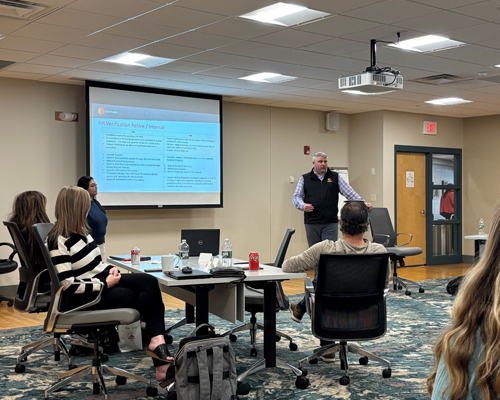
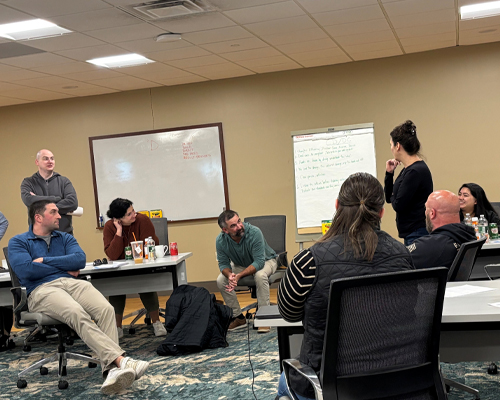
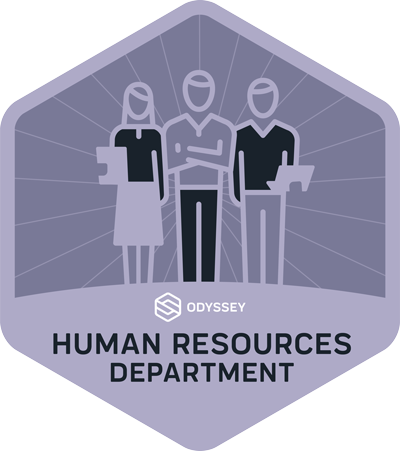
Human Resources
Over the past few months, the HR Team has been hard at work rolling out Odyssey’s new Performance Management process for both leadership and individual contributors across the company. This new process was initiated to make the process more efficient and effective in evaluating important leadership and individual contributor competencies while also enhancing critical feedback mechanisms.
![]() Additionally, on the heels of the recent Employee Engagement Survey, the HR Team have been conducting focus groups to gain more insight into areas of concern identified in the survey. The goal is to share the feedback from the focus groups with the Executive Leadership Team and provide specific recommendations for improvement in these areas.
Additionally, on the heels of the recent Employee Engagement Survey, the HR Team have been conducting focus groups to gain more insight into areas of concern identified in the survey. The goal is to share the feedback from the focus groups with the Executive Leadership Team and provide specific recommendations for improvement in these areas.
We also have been heavily involved in onboarding employees across several sites (Hanscom, San Antonio, and Colorado Springs) as a result of recent contract wins.
In the coming months, a new Manager Training curriculum will be launched to improve the effectiveness of our company leaders at all levels of the organization. Stay tuned for more information as the program is finalized!

Security
Much of the work performed by our corporate support functions goes largely unnoticed unless there is a hiccup in document processing. Our top-notch Security Team, however, was recognized by name in our Base Year Contractor Performance Assessment Report (CPAR), and for good reason. “Special commendation to the contractor security officer support for expedient coordination with the HBZ mission partner security manager and mission partner agents facilitating 108 CACs, security clearances, SCI, and SAP clearances for the incumbent workforce to be transitioned with minimal disruption to HBZ mission activities.” (AFLCMC/HB Contractor—Base Year CPAR) Kudos to Michael Laurie, our Director of Security and his entire team for a JOB WELL DONE!
In other news, Ryan Schlosser and Jamie Lufkin were recently promoted to managerial roles and will be leading two separate teams. Jamie will lead Life Sciences / C2ISR / CCN2 security tasks, and Ryan’s team will manage Space and Missiles / Aviation / Systems. Congratulations to Jamie and Ryan!
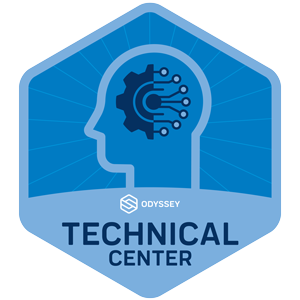
Technical Center
As we begin 2025, the Technical Center continues to be driven by our mission to sustain and advance Odyssey’s long-term technical excellence. Focused on delivering thought leadership, providing reach-back capability, and fueling growth, our mission is carried out by our talented team of Solution Architects and Technical Fellows.
Special recognition goes to Don Stevens, pictured below with Jessica Montana, and Gene Brandon, shown with Matt Kasberg, for their invaluable contributions in supporting the PM SSV Oral Proposal and impactful solutioning sessions in December. Their combined efforts showcase the core values of our Technical Center.
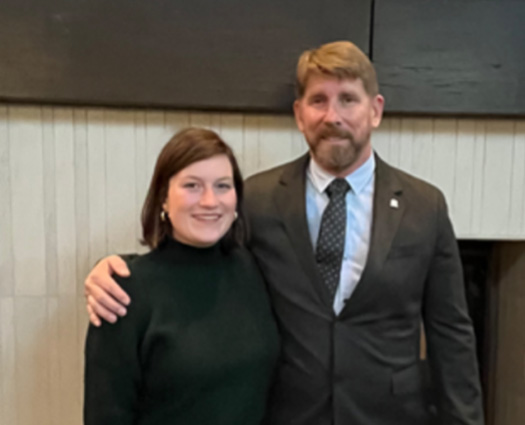
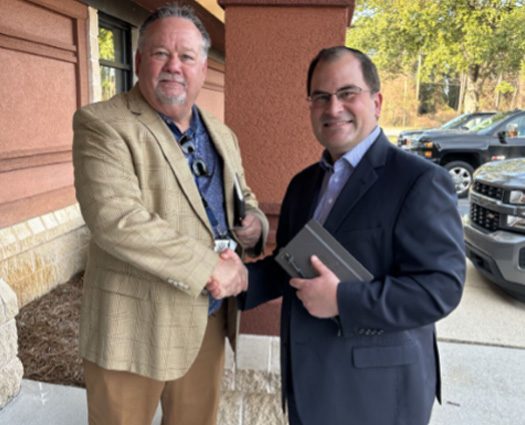
This past month, Gene also spearheaded the coordination of a Technical Center engagement with our Special Warfare TISC (AFLCMC/WI – ISR SOF) customer. Our boots-on-the-ground experts shared critical insights into Odyssey’s integration and assessment capabilities for the special operations community. Gene’s hands-on approach and commitment were key in making this visit such a success, helping strengthen our relationships and foster a collaborative environment.
 We are excited to announce and welcome Jessica Montana as our new Technical Implementation Manager. Jessica will be responsible for managing and integrating technical talent across Odyssey’s Technical Center, helping to establish innovative solutions to meet complex challenges. Her leadership will help drive collaboration and enhance Odyssey’s technical capabilities across all pillars.
We are excited to announce and welcome Jessica Montana as our new Technical Implementation Manager. Jessica will be responsible for managing and integrating technical talent across Odyssey’s Technical Center, helping to establish innovative solutions to meet complex challenges. Her leadership will help drive collaboration and enhance Odyssey’s technical capabilities across all pillars.
We’re also excited to welcome our new Technical Fellows for 2025 and thank all the Tech Fellows from 2024 for their continued commitment to excellence.
| Name | Technical Center Pillar |
|---|---|
| Andy Manvell | Data Science |
| Brandon Robinson | Data Science |
| Brian Cantrell | Logistics, Management |
| Chris Jabs | Logistics, Management |
| Clay Nepveux | Acquisition Management |
| Darren Morris | Systems & General Engineering |
| Don Stevens | Specialty Engineering |
| Jaime Socotch | Acquisition Management |
| Jonathan Hipps | Systems & General Engineering |
| Justin Franklin | Logistics Management |
| Ken Wanless | Specialty Engineering |
| Kiley Combs | Cyber Security |
| Lee Quarles | Logistics, Management |
| Maxwell Grindstaff | Cyber Security, Specialty Engineering |
| Michael Wells | Cyber Security |
| Mike Poplawski | Test & Evaluation |
| Nick Davis | Data Science |
| Phillip Hamann | Test & Evaluation, Specialty Engineering |
| Raymond Flores | Acquisition Management, Test & Evaluation |
| Rey Febo | Specialty Engineering, Systems & General Engineering |
| Shelby Foor | Pre-Clinical Science |
| Terrance McKeeby | Data Science, Cyber Security |
| Tim Fry | Specialty Engineering |
| Ting Wong | Pre-Clinical Science |
| Tony Mallia | Systems & General Engineering |
| Willie Mothersell | Logistics Management |
These experts, representing our core pillars in life sciences, cyber security, data science, logistics management, acquisition management, test and evaluation, systems and general engineering, and specialty engineering, bring invaluable expertise and fresh perspectives. Their contributions are set to strengthen our Technical Center’s capabilities, drive innovation and thought leadership, and enhance our comprehensive cross-domain capabilities.
Get ready! The Technical Center is hitting the road this year to connect with top talent and technical experts in our organization. Don’t miss your chance to meet with us at upcoming visits to Lincoln, Massachusetts, Colorado Springs, Colorado, Kirtland, New Mexico, and Dayton, Ohio. If you’re ready to join this exceptional group of experts, or if you know of someone that is interested, we invite you to complete the SharePoint form located here: https://forms.office.com/g/taRBqXiu77
Here’s to another year of growth, collaboration, and technical excellence!

Join us on April 17th for 3rd Thursday!
While our topic is still TBD, it’s sure to be relevant and interesting—we look forward to seeing you there!
Please remember to join 3rd Thursday Virtual Community Meetings every month—we highlight company news and a different part of our business on a rotating basis. Invitations for all 2025 3rd Thursday sessions are on your Odyssey calendar.
At the end of each 3rd Thursday session, Odyssey’s Executive Leadership Team will answer questions from team members—you can submit your questions using the button below.



